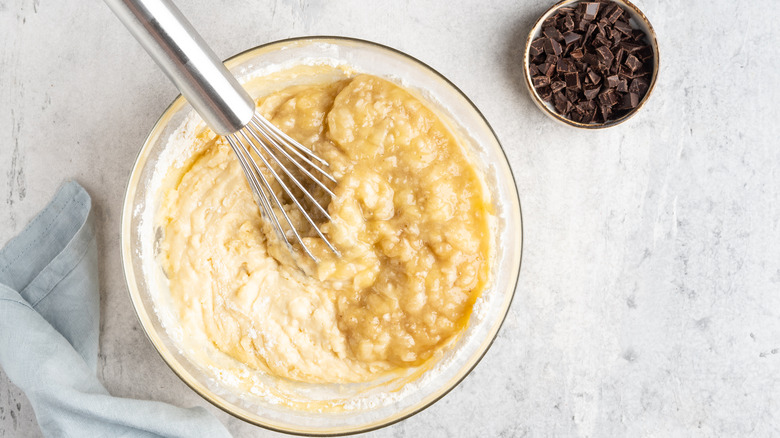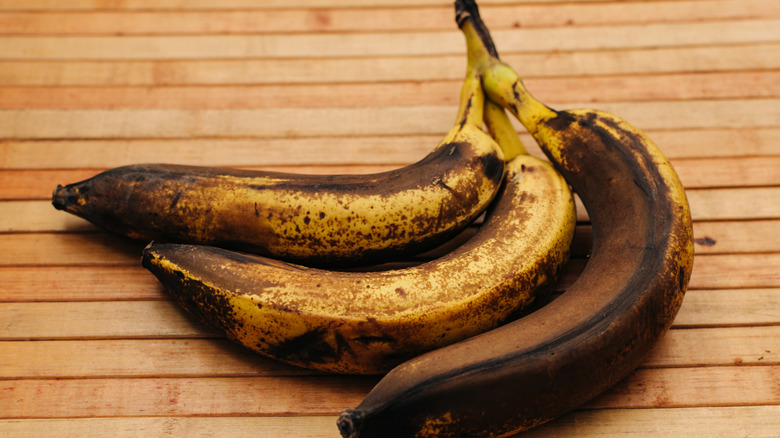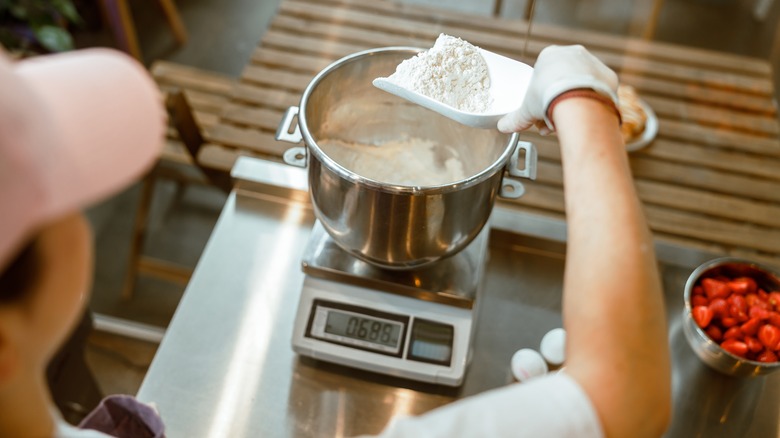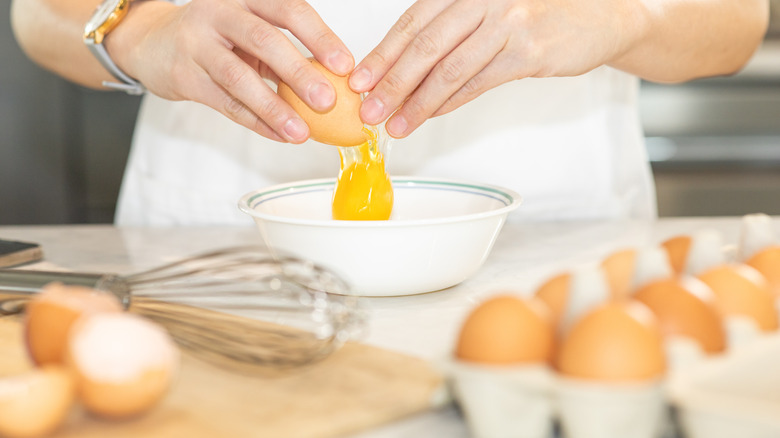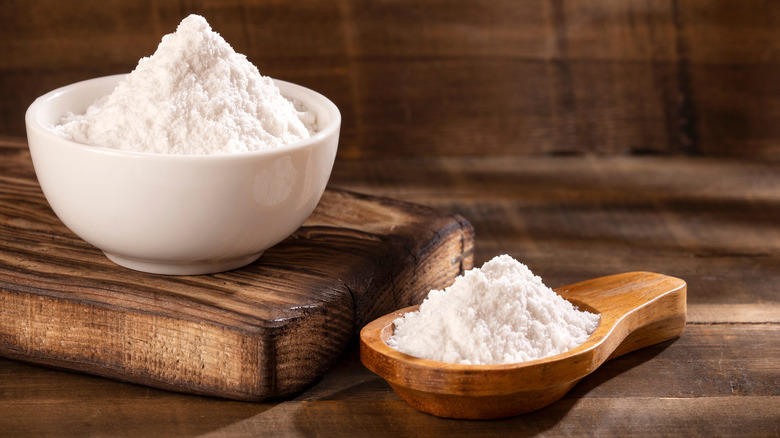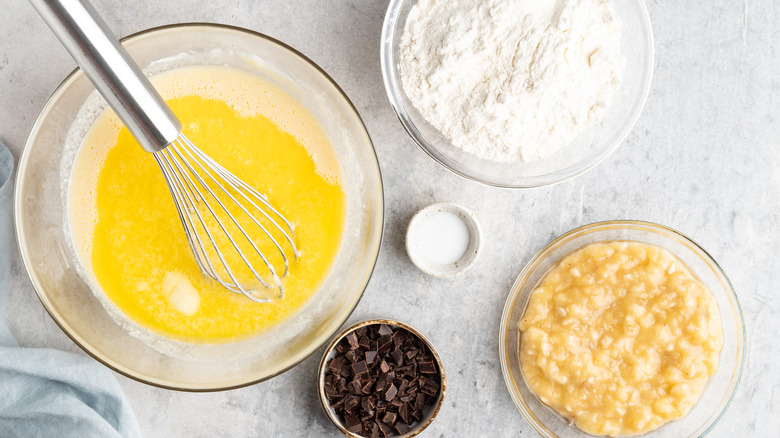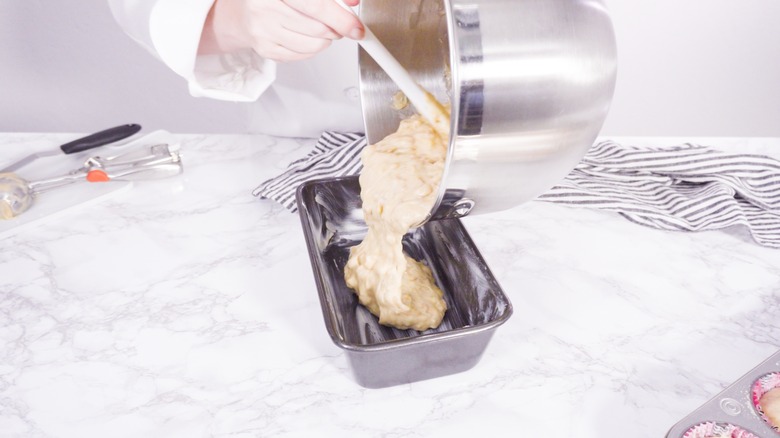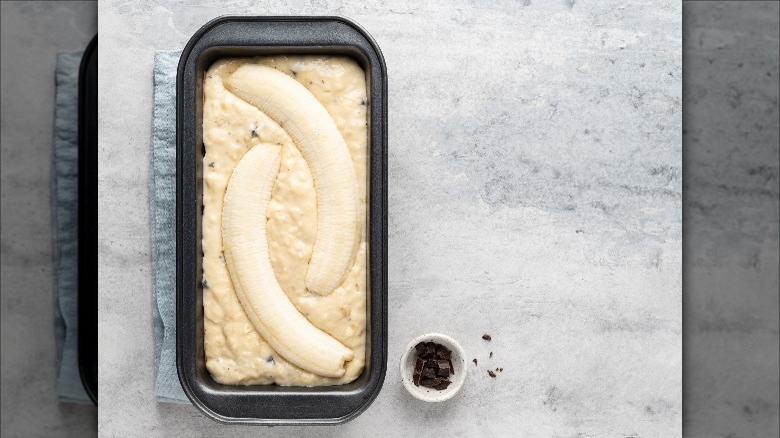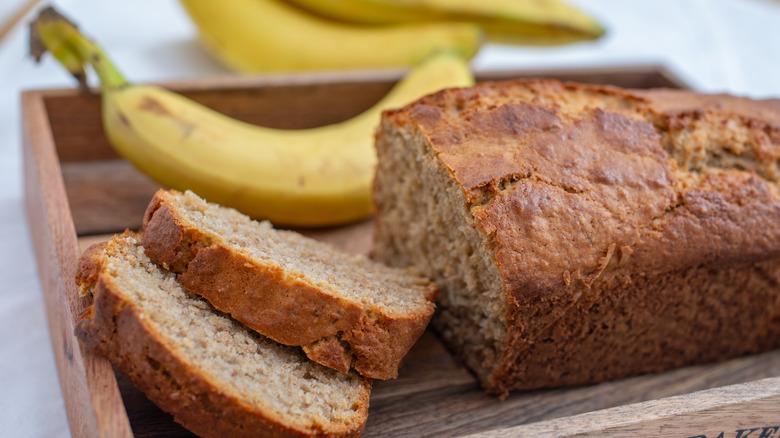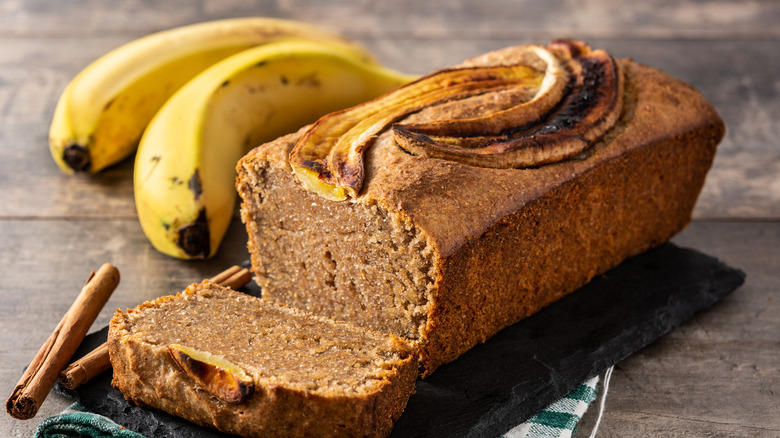The Biggest Mistakes Everyone Makes With Banana Bread
Back in 2020, at the start of the Covid-19 pandemic, it seemed like everybody was making banana bread. As grocery stores ran out of yeast, people turned to baking banana bread while in quarantine to pass the time. However, the popularity of this sweetened loaf is not a new phenomenon. By the 1930s, recipes for banana bread flooded the cookbook circuit (via King Arthur).
Nearly a century later, banana bread continues to be a favorite for a reason. It makes for a great breakfast, snack, or even dessert. You can easily tailor it to your tastes by adding mix-ins such as chocolate chips and nuts. And while it's also relatively simple to bake a loaf, there are plenty of ways to mess up this delightful treat. Whether you are following a family recipe or trying the latest trendy spin, avoid making these common banana bread baking mistakes and you will end up with delectable results every time.
Over-mixing the batter
Just like most baked goods, how you mix your banana bread batter is crucial. Novice bakers often fear under-mixing in an effort to avoid ending up with clumps of flour that will ruin the final product, but perfectly smooth batters do not necessarily mean you will get a pristine baked treat.
Mixing for too long can result in a dense and even gummy loaf. According to Baking Kneads, that unwanted texture occurs because too much gluten develops. You want strong gluten formation in yeasted breads, like brioche, but for quick breads like banana bread, it is a result you definitely want to avoid. To get a soft, tender crumb, mix until the dry ingredients are just combined into the batter, and then stop. Don't worry if there are visible lumps in your batter. As long as there aren't large amounts of unincorporated flour, the batter will even out while baking.
Using the wrong bananas
Not all bananas are meant for banana bread. Specifically, make sure to consider ripeness when choosing fruit for your bread. Overripe bananas have the best texture and level of sweetness to make a satisfying loaf. In the produce aisle, look for bananas that have started to turn brown. They may even be marked down in price. If you have the time, you can wait for more yellow bananas to turn black. While those blackened bananas are ideal for your loaf, be extra careful to avoid fruit that has gone bad. Signs of bananas being too ripe for your banana bread include visible spots of mold and a foul smell.
In a pinch, you can "ripen" the fruit in the oven. Bake unpeeled bananas in a 250 F oven for 15 to 20 minutes (via Daily Delish). Just keep in mind that this will not achieve the same level of sweetness and can affect your final product.
Not weighing ingredients
If you are getting inconsistent results in your loaves, you may be measuring your ingredients improperly. Improve your banana bread by weighing the ingredients. A digital scale is best for baking because it is more accurate. (If you're looking to invest in one, we recommend choosing a scale that weighs in both ounces and grams.)
Measuring by hand will produce different amounts of the same ingredient depending upon how you scoop. Adding too much flour will make your banana bread dry. Use too little, and your loaf will be too wet (via Leaf). That's why it's time to ditch those measuring cups. By using a scale, you can be sure you have the correct amount of flour every time. However, if you don't own one, the best way to measure ingredients is to spoon them into the measuring cup and then use a straight surface to level off the top.
Using too many eggs
Eggs are a vital part of baking. In baked goods like cakes and quick breads, they give structure and stability to the batter. Adding too many eggs while baking, however, will throw off the composition. The result could be a banana bread that is dense, spongy, and rubbery. Given that this baked treat is already a hefty product, you will want to avoid these unappetizing textures.
According to The Cake Blog, over doing it on the egg addition can also affect flavor. You may end up overwhelming those all-important banana notes, which is certain to make your bread less enjoyable. Our recipe for banana bread calls for just two eggs for a single loaf. This recipe is easy enough to double, but make sure to scale all ingredients. The ratios are key to get all the ingredients to work together in order to form the perfect loaf.
Using baking powder instead of baking soda
Many people think that baking powder and baking soda are interchangeable, but this is not the case. These leavening agents have chemical properties that make each better in certain circumstances. Baking soda should be used when baking with an acidic ingredient, such as bananas. The addition of buttermilk in many recipes also calls for using baking soda. This will provide additional benefits to your banana bread, as it tenderizes the gluten, adds flavor, and also results in a darker, crust (via Baking School).
So why is baking soda so essential? Without it, you won't achieve that all-important rise in your loaf, and you'll end up with a very dense product. If you don't happen to have a container of it in your pantry, there are a number of baking soda substitutes ranging from club soda to beaten egg whites. But we suggest waiting to get ahold of the real deal for optimal banana bread baking results.
Mixing ingredients in the wrong order
Baking recipes specify an order of mixing ingredients for a reason. Go out of order, and your batter will likely not come together properly. Most baking recipes call for dry ingredients (such as flour, salt, and leaveners) to be mixed separately before incorporating into the wet ingredients (via Stress Baking). This helps to more evenly distribute all your components.
A best practice is to read through your recipe and follow its directions. For our banana bread recipe, we recommend sifting the flour, cinnamon, baking soda, and salt in a bowl. In a separate bowl, beat the butter and sugar together and then add eggs one at a time. Mix in a third of the dry ingredients followed by half of the buttermilk. Repeat until all ingredients are incorporated, ending with the last of the dry ingredients. By following this order, you can ensure your batter will have the right consistency.
Not greasing the pan
How many times have you turned over a pan to release your baked good only to find it won't come out? You quickly realize you forgot to grease the pan. This very common mistake can put all your hard work to waste if you can't get your loaf out in one piece.
Properly greasing your bread pan will cause you a huge stress relief. Nonstick cooking spray will do the trick for baking your banana bread, but you can also take added measures. Try greasing the pan with shortening, butter, or cooking oil, spreading it throughout the bottom and sides with a paper towel. For the best results, you should also lightly dust the pan with flour after greasing. If you follow these steps, you can rest assured that your loaf will fall out of the pan after baking.
Not baking for long enough
Many people are shocked to see the bake time on most banana bread recipes. How could something in such a small pan take so long to bake? Remember that banana bread is a dense batter and need a considerable amount of time in those deep bread pans to fully bake.
If your banana bread is coming out raw in the middle, the most likely scenario is that you took it out of the oven too early (via What Banana). Most loaves will take at least 50 minutes to bake. A golden brown crust is expected, but appearances can be deceiving. Here are some tips for making sure your loaf is baked throughout. If you gently press your finger into the top of the loaf and it leaves a dent, you need to bake it longer. Additionally, insert a toothpick into the center of the bread. If it comes out clean, it has baked long enough.
Overbaking
While a gooey under-baked loaf is undesirable, you will also want to avoid baking your banana bread for too long, which will result in a dry loaf (via Cake Decorist). You can prevent this mistake by testing your bread prior to your timer going off. A few minutes before the end of the designated bake time, take the pan out of the oven and test with a toothpick. If the toothpick comes out wet, it needs more time to bake. A common misconception is that the toothpick has to be completely clean to indicate it's done baking. If only a few crumbs remain, you are good to go. Sticking it back in the oven at this point will likely result in overbaking.
If you accidentally leave the loaf in for too long, there are a couple quick fixes to repair your dry bread. You can lay a damp kitchen cloth over the loaf for a short period of time to reintroduce moisture (via Sweet Home Digest). Alternatively, you can make a simple syrup and soak your bread with it. Combine equal parts sugar and water and heat on the stove until the sugar dissolves. Poke holes in your bread with a skewer and spoon the syrup over the top of the loaf.
Not letting the loaf cool before slicing
You have patiently waited for your banana bread to bake in the oven for about an hour. It is completely natural to want to cut into it right away to enjoy your treat, but you'll have to hold off a little longer. Banana bread needs to fully cool before you slice into it.
As per our banana bread recipe, let your loaf cool in the pan for 10 minutes before removing it. The caramelization of the bananas during baking will make it too difficult to remove the loaf as soon as it comes out of the oven (via LiveStrong). It is also likely to fall apart when you flip the pan over. That initial cooling period gives a chance for the steam to condense and the loaf to solidify enough to stay intact.
After 10 minutes, invert the pan onto a plate or small cutting board. Gently lift the pan to release the bread before flipping it back over onto a wire rack to cool completely. This allows for the structure of the loaf to fully coagulate before slicing. If you prefer your banana bread warm, you can always heat it in the microwave for a few seconds.

